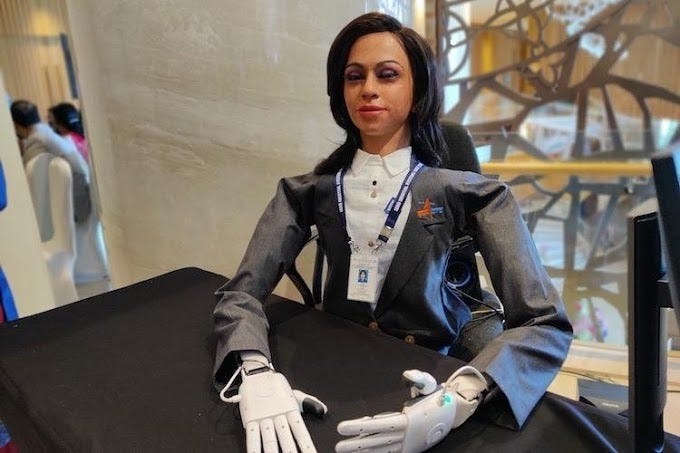Vyommitra: India’s Space Humanoid for the Gaganyaan Mission
Vyommitra, India’s first spacefaring humanoid robot. A unique combination of innovation, technology, and symbolism, Vyommitra is poised to play a critical role in India’s efforts to demonstrate human spaceflight capabilities.
TECHNOLOGY
Thinkbrief
7/13/20253 min read


India’s space exploration journey has been marked by a series of groundbreaking achievements. As the country prepares to launch its first manned space mission under the ambitious Gaganyaan programme, the spotlight is increasingly shifting to an unexpected participant—Vyommitra, India’s first spacefaring humanoid robot. A unique combination of innovation, technology, and symbolism, Vyommitra is poised to play a critical role in India’s efforts to demonstrate human spaceflight capabilities.
The name “Vyommitra” is derived from Sanskrit, combining “Vyoma” (meaning space) and “Mitra” (meaning friend), translating to “Friend in Space.” Vyommitra is a female-looking humanoid robot developed by the Indian Space Research Organisation (ISRO). She has been designed to serve as a human analog in the uncrewed test flights of the Gaganyaan mission, allowing ISRO to test and refine various critical systems before sending actual astronauts into space.
Vyommitra’s role is not merely symbolic. She is equipped with multiple sensors, speech recognition capabilities, and mechanical arms, enabling her to perform essential functions onboard the spacecraft. Her main tasks include monitoring environmental parameters like temperature, pressure, and oxygen levels, operating control panels, and communicating with mission control. By mimicking astronaut behavior and responding to commands, she helps test the crew module systems, ensuring they are safe and functional for human occupants.
The Gaganyaan mission is a massive undertaking. India aims to send a crew of three astronauts into low Earth orbit (LEO) for a period of up to seven days. Before this manned mission, ISRO has scheduled at least two uncrewed test flights. In both, Vyommitra will occupy one of the astronaut seats. She will perform activities that simulate human physiological responses and interactions within the spacecraft. This includes checking life support systems, validating the effectiveness of safety protocols, and relaying data back to Earth. In this way, she functions as both a tester and a safeguard, ensuring that all systems are astronaut-ready.
From a technological perspective, Vyommitra is a product of India’s growing prowess in robotics, AI, embedded systems, and aerospace engineering. Her design includes semi-autonomous behavior, natural language processing in English and Hindi, and the ability to identify and react to anomalies in the spacecraft’s operation. While she currently lacks a full humanoid structure—her body ends at the waist—her upper-body mobility and expression are sufficient for her current mission objectives. Future versions could include full-body movement and more complex interaction capabilities.
One of the most remarkable aspects of Vyommitra is her cultural and social symbolism. ISRO’s choice to make the robot female is a powerful statement about inclusivity and gender representation in science and technology. It reflects the growing role of women in India’s space program and serves as an inspiration for future generations of girls to pursue careers in STEM (Science, Technology, Engineering, and Mathematics). Vyommitra’s presence bridges not just human and machine, but also traditional and modern values, reinforcing India’s unique approach to innovation.
Her development also highlights India’s commitment to cost-effective yet high-quality technological solutions. Unlike nations that depend on expensive and imported robotics platforms, Vyommitra is entirely indigenously developed, showcasing the capabilities of Indian engineers and researchers. This indigenous development reinforces India’s goal of self-reliance in critical technology sectors and its broader vision under initiatives like “Make in India.”
Looking ahead, Vyommitra’s role is expected to evolve significantly. With advancements in AI and machine learning, future iterations of the robot could be equipped for complex diagnostics, assisting astronauts in zero-gravity tasks, or even participating in long-duration space missions such as lunar or Martian expeditions. Her successful deployment in Gaganyaan will lay the foundation for a new era of human-robot collaboration in space, where humanoid companions play critical roles in both safety and scientific discovery.
In conclusion, Vyommitra represents more than just a technological breakthrough. She is a symbol of India’s scientific ambition, cultural identity, and futuristic vision. As Gaganyaan prepares to send India’s first astronauts into space, Vyommitra will be their robotic forerunner—testing the path, collecting data, and ensuring that when the moment arrives, India will soar safely and confidently into the cosmos. Her presence affirms that the future of space exploration is not just about rockets and modules, but also about intelligent, empathetic machines that will journey alongside humanity into the unknown.